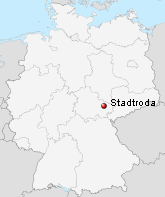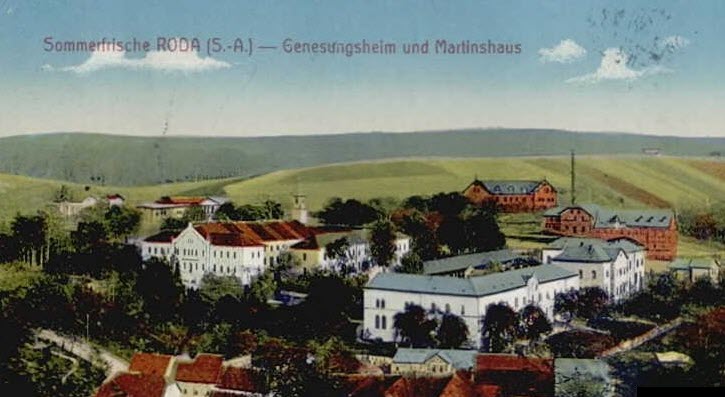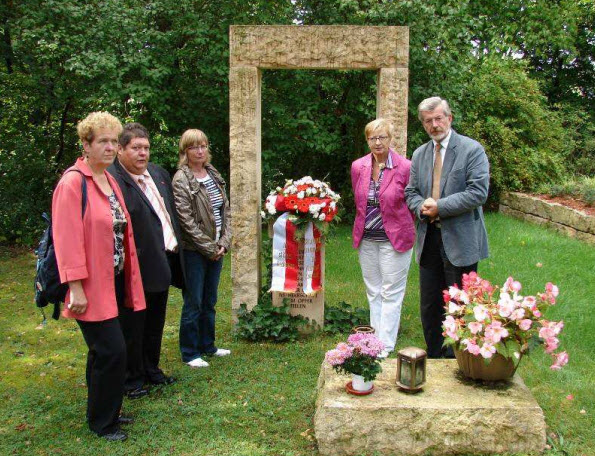Home
Stadtroda (Thüringische Landesheilanstalten
Stadtroda, after Feb. 1943 Thüringisches
Landeskrankenhaus Stadtroda)

The Kinderfachabteilung in Stadtroda was established in October 1942 at
the latest (as the only such ward in what today is the state of Thuringia)
and continued to operate until the end of World War II. The clinic's medical
director was Dr. Gerhard Kloos, and the physician responsible for the
"special children's ward" was Dr. Margarete Hielscher. Dr. Kloos continued
his medical career after the war in West Germany until his retirement in
1968. He died in 1968. Even though the Stasi discovered her involvement in
the killing as perpetrator, Dr. Hielscher received political protection in
the East German Republic, where she served as director of the pediatric
section of neuro-psychiatry at Stadtroda until her retirement in 1965. She
died in 1985.
It has been estimated that 133 children died in the special children's ward
in Stadtroda. However, even before the establishment of the ward, at least
70 children died either because life-saving treatment was withheld or were
killed through medication.
These figures established in the research of S. Zimmermann and R. Renner
have been indirectly called into question by the physicians J. Kasper and M.
Lembke, who in the context of a book commissioned by the state medical
association, whose apparent purpose is to exculpate the physician Jussuf
Ibrahim in regard to his involvement in Euthanasia, interpret medical
evidence in a way that arrives at very conservative figures.
The Kinderfachabteilung was housed in the historic Martinshaus, which has
been torn down since.
Source: author; http://maik-nothnagel.de/images/PDF/stadtroda.pdf
In the post-WW II period, the author on occasion of the 100th anniversary of
the institution in 1948 merely notes a "high mortality" for the war years
but makes no mention of the role of Stadtroda in "euthanasia" crimes (Buchda
1948: 49). When in the 1960s the clinic director informed the Ministerium
für Staatssicherheit (Stasi) that medical records point to "euthanasia"
crimes at the site during the Nazi years, and further investigations by the
Stasi substantiated these charges, the records were sealed in an archive and
no persecution took place.
In 1985 K. Masuhr and G. Aly published a detailed expose on the crimes of
Dr. Kloos in Stadtroda; it also included details on the involvement on Dr.
Hielscher as well as the University Children's clinic's role in sending
children to Stadtroda. State authorities in East Germany began anew to look
into the matter but still did not pursue a persecution (see Aly 2000);
however, in 1986, the then-director of the pediatric section of
neuro-psychiatry at the facility, S. Köhler, in a public lecture on occasion
of the 100-year anniversary of the existence of this section not only
described the "children's euthanasia" action at Stadtroda but also mentioned
Dr. Hielscher's murderous involvement and post-war career at the facility
(as one of her predecessors) - an unusual acknowledgement in East Germany at
the time. S. Zimmermann and G. Wieland presented a further short overview on
medical crimes against children in 1989. Subsequent interrogations have shed
more light on the subject matter, including the role of the once-esteemed
pediatrician Dr. Jussuf Ibrahim (here)
and the cover-up by the Stasi (Wanitschke 2005).
The Arbeitskreis zur Erforschung der Geschichte der NS-"Euthanasie" und der
Zwangssterilisation (Working Group for Research on the History of
NS-"Euthanasia" and Compulsory Sterilization) met in Stadtroda in 1997.
Several contributions to the conference addressed the history of the medical
crimes during the Nazi period there.
In 1998 a memorial created by Karola Nitz was dedicated in the park of the
Landesfachkrankenhaus für Psychiatrie und Neurologie, with support from the
directors of the clinic and the association of mental patients "Die Brücke"
(The Bridge). The archway symbolizes the gate of the clinic through which
people were sent to die, and the book addresses the history of the
institution and serves as a warning. The inscription reads: "In memory of
the patients of this hospital who between 1941 and 1945 fell victim to the
murderous actions under Nazi rule." The historical chronicle on the website of the clinic (no
longer available) referred vaguely to "inhumane violence" that was
perpetrated between 1933 and 1945.
It does not appear that commemorative events take place on site on a regular
basis, but in 2008 a commission of the state diet visited the clinic and
laid a wreath (see here).
An extensive exhibition "Transport in den Tod"
(transfer to death) also commemorates the past events (see exhibitions).
In 2012, the teacher-in-training M. Salomon carried out
activities with students in a local school to study "euthanasia" crimes in
Stadtroda (see Salomon 2012).
Literature
Aly, Götz.
2000.
"Menschenfreund und Mordgehilfe." Berliner
Zeitung 4 May.
Arbeitskreis zur Erforschung der Geschichte der NS-"Euthanasie" und der
Zwangssterilisation, ed. 1997. Herbsttagung
1997 in Stadtroda. N.p.: Arbeitskreis zur Erforschung der
Geschichte der NS-"Euthanasie" und der Zwangssterilisation. Available at http://gedenkort-t4.eu/de/gegenwart/arbeitskreis
(see link there).
Benzenhöfer, Udo. 2003. "Genese und Struktur der
'NS-Kinder- und Jugendlicheneuthanasie.'" Monatsschrift
für Kinderheilkunde 151: 1012-1019.
Breidbach, Olaf et al. 2000. "Bericht der Kommission 'Kinderklinik Jussuf
Ibrahim.'" Available at http://www.uni-jena.de/unijenamedia/ibrahim.pdf
Buchda, Gerhard. 1948. Das
Landeskrankenhaus in Stadtroda 1848-1948: Festschrift zur Erinnerung an
das hunderjährige
Bestehn der Anstalt. Stadtroda: n.p.
Kasper, Johannes M. 2008. "Die nationalsozialistische Kindereuthanasie in
Stadtroda: Ein Beitrag anhand von Krankenakten aus neuropädiatrischer
Sicht." Pp. 171-96 in Menschliche
Verantwortung gestern und heute: Beiträge
und Reflexionen zum nationalsozialistischen Euthanasie-Geschehen in
Thüringen und zur aktuellen Sterbedebatte, edited by Eggert
Beleites. Jena: Landesärztekammer Thüringen.
Köhler, Susanne. 1986. "Von der Blödenanstalt zur klinischen Abteilung für
Kinderneuropsychiatrie (100 Jahre Kinderneupsychiatrie Stadtroda)." Public
lecture in Stadtroda on 7 April 1986.
Lemke, Sebastian. 2008. "22 Stadtrodaer Kinderschicksale: Fakten aus der
Sicht eines Klinikers." Pp. 197-222 in Menschliche
Verantwortung gestern und heute: Beiträge
und Reflexionen zum nationalsozialistischen Euthanasie-Geschehen in
Thüringen und zur aktuellen Sterbedebatte, edited by Eggert
Beleites. Jena: Landesärztekammer Thüringen.
Masuhr, Karl F, and Götz
Aly. 1985. "Der diagnostische Blick des Gerhard Kloos." Pp. 81-105 in Reform und Gewissen: "Euthanasie" im Dienst
des Fortschritts, by Götz Aly et al. Berlin: Rotbuch Verlag.
Platz, Wolfram E., and Volkmar Schneider, eds. 2008.
Dokumente einer Tötungsanstalt: "In den Anstalten gestorben." Part
2. Berlin. Hentrich & Hentrich.
Renner, Renate. 2004. "Zur Geschichte der Thüringer Landesheilanstalten/des
Thüringer Landeskrankenhauses Stadtroda 1933 bis 1945 unter besonderer
Berücksichtigung der nationalsozialistischen 'Euthanasie.'" M.D. Diss.,
Medical College, Friedrich-Schiller-Universität Jena.
Salomon, Michael. 2012."'Euthanasie in Thüringen – die systematische
Vernichtung von Minderheiten' – eine aktive Auseinandersetzung mit
Erinnerungskultur am Beispiel der Fachklinik und Gemeinde Stadtroda im
Nationalsozialismus zur weiteren Entwicklung der historischen Selbst- und
Sachkompetenz einer 9. Klasse der Regelschule." Zweite Staatsexamensarbeit,
Staatliches Studienseminar für Lehrerausbildung Gera, Lehramt an
Regelschulen (Thesis in preparation for becoming a history teacher).
Topp, Sascha. 2004. “Der ‘Reichsausschuss zur wissenschaftlichen Erfassung
erb- und anlagebedingter schwerer Leiden’: Zur Organisation der Ermordung
minderjähriger Kranker im Nationalsozialismus 1939-1945.” Pp. 17-54 in Kinder
in der NS-Psychiatrie, edited by Thomas Beddies and Kristina Hübener.
Berlin-Brandenburg: Be.bra Wissenschaft.
———. 2005. "Der 'Reichsausschuß zur wissenschaftlichen
Erfassung erb- und anlagebedingter schwerer Leiden': Die Ermordung
minderjähriger Kranker im Nationalsozialismus 1939-1945." Master's Thesis
in History, University of Berlin.
Wanitschke, Matthias, ed. 2005. Archivierter
Mord: Der SED-Staat und die NS-"Euthanasie"-Verbrechen in Stadtroda.
Erfurt: Landeszentrale für politische Bildung Thüringen.
Zimmermann, Susanne, ed. 2007. Überweisung
in den Tod: Nationalsozialistische "Kindereuthanasie" in Thüringen.
Erfurt: Landeszentrale für politische Bildung Thüringen.
Zimmermann, Susanne and G. Wieland. 1989. "Die Kinderfachabteilung
Stadroda/Thüringen unter der Leitung des Psychiaters Gerhard Kloos: Ein
Beispiel der faschistischen Vernichtungspolitik 'lebensunwerten
Lebens.'" Pp. 213-16 in Das Schicksal der
Medizin im Faschismus, edited by A. Thom and S. M. Rapoport.
Berlin: VEB Verlag Volk und Gesundheit.
Last updated: 25 Feb. 2015




